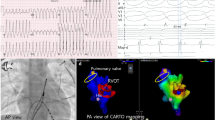Abstract
Junctional tachycardias comprise several arrhythmia types with differing mechanisms, principally involving the region of the atrioventricular (A-V) junction. Neonatal radiofrequency catheter ablation has typically been reserved for life-threatening, drug-refractory cases due to the unique concerns regarding patient size and development. We performed radiofrequency catheter ablation on two neonates with incessant, rapid junctional tachycardias and hemodynamic compromise after failing conventional medical therapy. This report describes 2 neonates who underwent emergent radiofrequency catheter ablation, and compares these two patients to a larger pediatric catheter ablation patient cohort. Both neonates had an acutely successful outcome and were able to be discharged within a week of the ablation procedure. Fluoroscopy time and total procedure time were shorter in these two patients than in the course of the average pediatric catheter ablation. Though long-term developmental consequences of neonatal catheter ablation are yet unknown, in unique extreme situations, radiofrequency catheter ablation can be performed in neonates, as in older children and adults, without excessive acute morbidity.
Similar content being viewed by others
References
Scheinman MM, Gonzalez RP, Cooper MW, Lesh MD, Lee RJ, Epstein LM. Clinical and electrophysiologic features and role of catheter ablation techniques in adult patients with automatic atrioventricular junctional tachycardia. Am J Cardiol 1994;74:565–572.
Garson A, Gillette PC. Junctional ectopic tachycardia in children: electrocardiography, electrophysiology, and pharmacologic response. Am J Cardiol 1979;44:298–302.
Villain E, Vetter VL, Garcia JM, Herre J, Cifarelli A, Garson A. Evolving concepts in the management of congenital junctional ectopic tachycardia: a multicenter study. Circulation 1990;81:1544–1549.
Walsh EP, Saul JP, Sholler GF, Triedman JK, Jonas RA, Mayer JE, Wessel DL. Evaluation of a staged treatment protocol for rapid automatic junctional tachycardia after operation for congenital heart disease. J Am Coll Cardiol 1997; 29:1046–1053.
Campbell RWF. Supraventricular tachycardia. In: Wren C, Campbell RWF, eds. Pediatric Cardiac Arrhythmias. Oxford: Oxford University Press, 1996;108–109.
Critelli G, Gallagher JJ, Monda V, Coltorti F, Scherillo M, Rossi L. Anatomic and electrophysiologic substrate of the permanent form of junctional reciprocating tachycardia. J Am Coll Cardiol 1984;4:601–610.
Kugler JD, Danford DA, Deal BJ, Gillette PC, Perry JC, Silka MJ, VanHare GF, Walsh EP, and Pediatric EP Society. Radiofrequency catheter ablation for tachyarrhythmias in children and adolescents. N Eng J Med 1994;330:1481–1487.
Kugler JD. Radiofrequency catheter ablation for supraventricular tachycardia: should it be used in small children? Circulation 1994;90:639–641.
Denfield SW, Kearney DL, Michael L, Gittenberger-deGroot A, Garson A. Developmental differences in canine cardiac surgical scars. Am Heart J 1993;126:382–389.
Saul JP, Hulse JE, Papagiannis J, Van Praagh R, Walsh EP. Late enlargement of radiofrequency lesions in infant lambs. Circulation 1994;90:492–499.
Case CL, Gillette PC, Oslizlok PC, Knick BJ, Blair HL. Radiofrequency catheter ablation of incessant, medically resistant supraventricular tachycardia in infants and small children. J Am Coll Cardiol 1992;20:1405–1410.
Walsh EP, Saul JP, Hulse JE, Rhodes LA, Hordof AJ, Mayer JE, Lock JE. Transcatheter ablation of ectopic atrial tachycardia in young patients using radiofrequency current. Circulation 1992;86:1138–1146.
Van Hare GF, Lesh MD, Scheinman MM, Langberg JL. Percutaneous radiofrequency catheter ablation for supra-Ventricular arrhythmias in children. J AmColl Cardiol 1991 17:1613–1620.
Schluter M, Kuck K-H. Radiofrequency current for catheter ablation of accessory atrioventricular connections in children and adolescents: emphasis on the single-catheter technique. Pediatrics 1992;89:930–935.
Ticho BS, Saul JP, Hulse JE, De W, Lulu J, Walsh EP. Variable location of accessory pathways associated with the permanent form of junctional reciprocating tachycardia and confirmation with radiofrequency ablation. Am J Cardiol 1992; 70:1559–1564.
Van Hare GF, Velvis H, Langberg JL. Successful transcatheter ablation of congenital junctional ectopic tachycardia in a ten-month old infant using radiofrequency energy. PACE 1990;13:730–735.
Rychik J, Marchlinski FE, Sweeten TL, Berul CI, Bhat AM, Collins-Burke C, Vetter VL. Transcatheter radiofrequency ablation of congenital junctional ectopic tachycardia in infancy. Pediat Cardiol 1997;18:447–450.
Author information
Authors and Affiliations
Rights and permissions
About this article
Cite this article
Berul, C.I., Hill, S.L., Wang, P.J. et al. Neonatal Radiofrequency Catheter Ablation of Junctional Tachycardias. J Interv Card Electrophysiol 2, 91–100 (1997). https://doi.org/10.1023/A:1009777126508
Issue Date:
DOI: https://doi.org/10.1023/A:1009777126508




